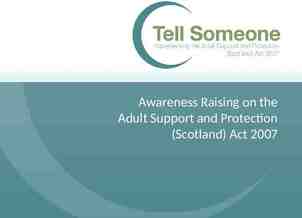Vaping Presented by: Campus Health Center
16 Slides7.27 MB
Vaping Presented by: Campus Health Center
Vaping and E-cigarettes Vaping is the act of inhaling and exhaling aerosol produced by ecigarettes or other devices E-cigarettes are battery operated devices that individuals use to inhale an aerosol, which typically contains nicotine, flavoring and other chemicals. Known as electronic nicotine delivery systems (ENDS)
Main Components E-cigarettes mainly contain four components A liquid chemical, referred to as ejuice Cartridge Battery, the power source Atomizer, which is a heating element
E-Liquid The main component of ecigarettes is the e-liquid or e-juice Contains nicotine, propylene glycol, glycerin,, flavorings, heavy metals and other chemicals that are harmful
E-Cigarettes: Nicotine and Flavorings Nicotine is a stimulant drug that speeds up the messages traveling between the brain and body. Very addictive substance found in tobacco products E-cigarettes come in many flavorings, such as mint, bubble gum, cotton candy, and with fruit flavors being the most popular among youth Can increase the risk of cardiovascular disease when inhaled
Names and Shapes E-cigarettes come in a variety of names and shapes, such as: E-cigs E-hookahs E-pipes Vapes or vape pens Resembling USBs
Who is using E-cigarettes? Mostly common among the youth population High school students are using e-cigarettes more than any other tobacco product As of 2019, around 5.3 million U.S. students are using ecigarettes 1 out 10 middle school students (10.5%) 1 out 4 high school students (27.5%) For Print Only
Growth Trends E-cigarettes use have increased among the youth population in the past years Use among high school students increased from around 12% to 22% in the years 2017 and 2018 There's a lower percentage of middle school students using e-cigarettes than high school students
Adult use of Ecigarettes The younger adult population is using ecigarettes more often
What is JUUL A brand of e-cigarettes that’s popular among the youth and young adult population JUULs resemble USB flash drives JUUL pods contain nicotine salts and they don’t produce vapor when the device is used One JUUL pod contains contains 20 cigarettes of nicotine – that’s one pack of cigarettes
JUUL A JUUL with pods in different flavors
Outbreaks CDC, Food and Drug Administration, state and local department and other public health organizations are investigating outbreaks of ecigarette, or vaping, product use associated lung injuries (EVALI) As of December 2019: 2,561 EVALI cases were reported to the CDC from all over the country Out of the EVALI cases reported, 55 deaths have occurred Laboratory findings show that vitamin E acetate is associated with the EVALI outbreak Vitamin E acetate is an additive in THC-containing e-cigarette products
Known Health Effects Due to containing nicotine, it can be quite addictive, affecting the development of fetuses and adolescent’s brain, which continues into their mid-20s. It affects areas of the brain that are responsible for attention, memory, learning, and brain plasticity
Know Health Effects Lung related illnesses include symptoms such as: Coughing Shortness of breath Chest pain Gastrointestinal symptoms Nausea Vomiting Stomach pain
What Can We Do? Talk with young people Have a conversation with children and teenagers about the risks and dangers of using e-cigarettes Explain what nicotine is and how it harms their brain development. Talk about nicotine addiction with them Reduce young people’s exposure to e-cigarettes If you use e-cigarettes or know someone who does, don’t allow them to be used in front of them Lead by example and they will learn and follow your positive behaviors Talk to your health care provider To get reliable and credible information, speak with your provider to educate your children on the health risks
References About Electronic Cigarettes (E-Cigarettes). (2019, November 26). Retrieved December 10, 2019, from https://www.cdc.gov/tobacco/basic information/e-cigarettes/about-e-cigarettes.html. E-Cigarettes and Lung Health. (n.d.). Retrieved December 10, 2019, from https://www.lung.org/stop-smoking/smoking-facts/e-cigarettes-and-lung-health.html. Know the Risks: E-cigarettes & Young People: U.S. Surgeon General's Report. (n.d.). Retrieved December 27, 2019, from https://e-cigarettes.surgeongeneral.gov/default.htm. Outbreak of Lung Injury Associated with the Use of E-Cigarette, or Vaping, Products. (2019, December 6). Retrieved December 10, 2019, from https://www.cdc.gov/tobacco/basic information/e-cigarettes/severe-lung-disease.html. What We Know About Electronic Cigarettes: Smokefree. (n.d.). Retrieved December 10, 2019, from https://smokefree.gov/quit-smoking/ecigs-menthol-dip/ecigs.





















